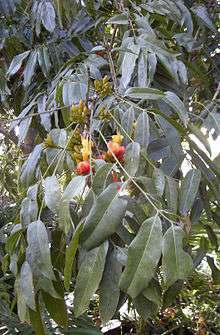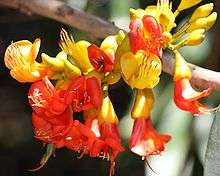Castanospermum
| Castanospermum | |
|---|---|
 | |
| C. australe | |
| Scientific classification | |
| Kingdom: | Plantae |
| (unranked): | Angiosperms |
| (unranked): | Eudicots |
| (unranked): | Rosids |
| Order: | Fabales |
| Family: | Fabaceae |
| Subfamily: | Faboideae |
| Tribe: | Angylocalyceae[1] |
| Genus: | Castanospermum A.Cunn ex Hook. |
| Species: | C. australe |
| Binomial name | |
| Castanospermum australe A.Cunn & C.Fraser ex Hook. | |
Castanospermum australe (Moreton Bay Chestnut or Blackbean), the only species in the genus Castanospermum,[2][3] is a flowering plant in the family Fabaceae, native to the east coast of Australia in Queensland and New South Wales, and to the Pacific islands of Vanuatu, New Caledonia, and the island of New Britain (Papua New Guinea). Members of this genus accumulate iminosugars in their leaves.[4]
Growth
It is a large evergreen tree growing to 40 metres (130 ft) tall, though commonly much smaller. The leaves are 15 centimetres (5.9 in) long and 6–7 centimetres (2.4–2.8 in) broad, pinnate, with 11-15 leaflets. The flowers are bicoloured red and yellow, 3–4 centimetres (1.2–1.6 in) long, produced in racemes 6 centimetres (2.4 in) long. The fruit is a cylindrical pod 12–20 centimetres (4.7–7.9 in) long and 4–6 centimetres (1.6–2.4 in) diameter, the interior divided by a spongy substance into one to five cells, each of which contains a large chestnut-like seed.
Uses
The seeds are poisonous, but become edible when carefully prepared by roasting, cutting up into small pieces, leaching with running water for several days, and pounding into flour. The timber, which somewhat resembles walnut, is soft, fine-grained, and takes a good polish, and the hardwood is very durable.
 Castanospermum australe flower
Castanospermum australe flower- Small C. australe tree
 Mature pod and seeds
Mature pod and seeds
References
- Australian National Botanic Gardens: Castanospermum australe
- Bush Tucker Plants: Moreton Bay Chestnut
- Plants for a Future: Castanospermum australe
 This article incorporates text from a publication now in the public domain: Chisholm, Hugh, ed. (1911). "article name needed". Encyclopædia Britannica (11th ed.). Cambridge University Press.
This article incorporates text from a publication now in the public domain: Chisholm, Hugh, ed. (1911). "article name needed". Encyclopædia Britannica (11th ed.). Cambridge University Press.
- ↑ Cardoso D, Pennington RT, de Queiroz LP, Boatwright JS, Van Wyk BE, Wojciechowski MF, Lavin M (2013). "Reconstructing the deep-branching relationships of the papilionoid legumes". S Afr J Bot. 89: 58–75. doi:10.1016/j.sajb.2013.05.001.
- ↑ "ILDIS LegumeWeb entry for Castanospermum". International Legume Database & Information Service. Cardiff School of Computer Science & Informatics. Retrieved 30 January 2014.
- ↑ USDA; ARS; National Genetic Resources Program. "GRIN species records of Castanospermum". Germplasm Resources Information Network—(GRIN) [Online Database]. Beltsville, Maryland: National Germplasm Resources Laboratory. Retrieved 30 January 2014.
- ↑ Kite GC, Cardoso D, Lewis GP, Zartman CE, de Queiroz LP, Veitch NC (2015). "Monomethyl ethers of 4,5-dihydroxypipecolic acid from Petaladenium urceoliferum: Enigmatic chemistry of an enigmatic legume". Phytochem. 116: 198–202. doi:10.1016/j.phytochem.2015.02.026. PMID 25817832.
| Wikispecies has information related to: Castanospermum |
| Wikimedia Commons has media related to Castanospermum. |